Maybe you forgot and put your new jeans in the wash with your best bath towels, or perhaps your kid dyed her hair pink and now has red stains dotting her favorite sweatshirt. Can you put the stained clothes in the wash or will that make things even worse? Once in a while, almost everyone comes across an unfortunate dye stain that leaves you wondering how to get dye out of clothes!
The best way to get dye out of clothes is to treat the stain with a natural remover such as white vinegar or rubbing alcohol. Commercial products like oxygen bleach also do a great job lifting many types of dye stains out of clothing. Some dyes such as hair dye require multiple treatments to remove all of the color from clothing.
In this article, you will learn eight common methods for removing dye stains from clothes. You will get tips for how to handle special kinds of dyes such as red or blue dye. Finally, you will discover how to get dye out of clothes after washing.
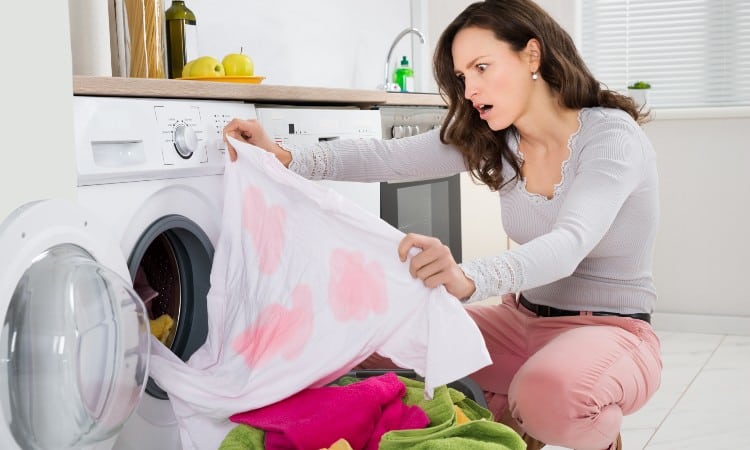
Can You Remove Dye From Clothes?
Most of the time, you can remove dye from clothes by applying rubbing alcohol to the stain or soaking the garments in a white vinegar solution. Many commercial stain removers or oxygen bleach also do a good job removing color bleed or dye transfer. In some cases, white clothing may require chlorine bleach to truly remove any dye stains.
The easiest way to get any type of dye out of your clothing is to catch the stain while it is fresh. After you wash your clothing and put it through the dryer, it becomes much more difficult to lift dye out of the fabric.
What kind of fabric does your shirt or pants contain? This also makes a big difference when treating stains.
If you have a dry-clean-only garment, you should not attempt any DIY stain removal methods! Instead, take your garment into the cleaner and explain what caused the stain. Certain types of fabric like wool and silk also will not respond well to most at-home cleaning methods, so make sure you read the care label inside your garment before applying a stain remover!
Of course, the type of dye that made the stain also matters! You will want to treat hair dye in a different way than red or blue dye, as you will find out later in this article.
How to Get Dye Out of Clothes: 8 Methods
You can safely remove most dye stains by trying one of these eight simple methods for dye removal. If you don’t like strong chemicals or prefer to go with a cheaper option, try one of the five home remedy options. These require only basic household products and a bit of elbow grease!
On the other hand, sometimes a commercial cleaner really does the job more quickly and effectively. In that case, you will want to check out the commercial removers listed later in this section.
What Home Remedy Removes Dye from Clothes?
The most popular and widely effective home remedy that removes dye from clothes is rubbing alcohol, followed closely by white vinegar. You can apply these products in several different ways depending on the type of garment and kind of stain.
Baking soda, hydrogen peroxide, and ammonia can also do a great job removing dye stains, depending on the type of stain.
As a word of caution, you should always spot-test any of these products on an inside seam allowance before applying the product to an obvious spot on your clothing. This lets you make sure the product will not damage your clothing. For instance, vinegar does a fantastic job removing stains, but it can also cause colors to fade out of clothes in some cases.
1. Vinegar
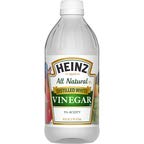 Vinegar has acidic properties that make it an excellent stain remover for many different types of stains, including several types of dye. Plus, vinegar may not smell great but it does not let off dangerous fumes like some kinds of bleach. You can safely splash vinegar on your skin without causing injuries, too.
Vinegar has acidic properties that make it an excellent stain remover for many different types of stains, including several types of dye. Plus, vinegar may not smell great but it does not let off dangerous fumes like some kinds of bleach. You can safely splash vinegar on your skin without causing injuries, too.
How does vinegar remove dye transfer from clothes? You can try two simple methods.
The simplest method is to soak the garment, but the second gives you an option to spot-treat clothing more quickly, or to treat a stained sofa or carpet.
To soak a dye-stained garment in vinegar:
- Attach a safety pin in the clothing near the stain. This way you can find the spot again later to make sure the stain disappeared!
- Fill a clean bucket or washbasin with cool water. You need enough water to cover the garment easily.
- Measure in one cup of distilled white vinegar.
- Submerge the clothing into this solution and allow it to soak for half an hour.
- Rinse out the vinegar under cool running water. Try not to wring out the garment, as this could damage the material. instead, press extra water out with your hands.
- Put the wet clothing in your washing machine, and run it through a cool water cycle with your normal detergent.
- Do not put the clothing in the dryer once the washer finishes Instead, hang it up to air dry.
- Finally, check for the stain and see if it all came out!
The other way to remove dye stains using vinegar takes less time but a bit more personal attention.
- Find a clean white rag and a clean measuring cup or bowl.
- Measure two cups of warm water, one cup of distilled white vinegar, and one tablespoon of dish soap into the container. Stir this up with a spoon till the soap dissolves and you see some bubbles.
- Soak a corner of the white rag in this solution, and use it to blot the stain. Do not scrub at the stain, just dab at it.
- When you see dye transferring to the white rag, switch to a different corner.
- Keep blotting until all the color transfers to the rag!
- Rinse the area under cool running water to remove the cleaning solution from the fabric.
- If you still see a bit of dye at this point, move on to the rubbing alcohol method.
- If the stain is gone, you’re good to go! Just make sure you don’t put this garment in the dryer next time you wash it.
2. Rubbing Alcohol
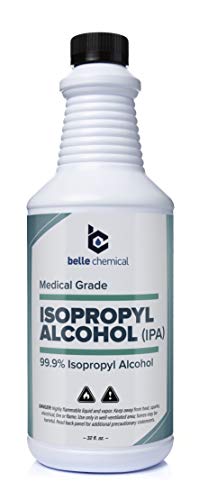 You can safely apply rubbing alcohol to most types of fabric without causing any damage. Rubbing alcohol, or isopropyl alcohol, acts as a natural stain remover for most types of stains, too!
You can safely apply rubbing alcohol to most types of fabric without causing any damage. Rubbing alcohol, or isopropyl alcohol, acts as a natural stain remover for most types of stains, too!
To spot-clean a dye stain with rubbing alcohol:
- Slide a piece of cardboard or thick, folded paper towel between the stained part of the garment and any other parts. For example, if the stain is on the front of a shirt, put a buffer inside the shirt so you do not accidentally soak through to the back of the shirt!
- Soak a cotton ball in rubbing alcohol and blot the stain with it. When you start to see color staining the cotton ball, discard it and use a new cotton ball.
- Once the bulk of the dye seems gone, turn the garment inside out and locate the stain from the back of the fabric. You should find this easily, as the alcohol will have left a large damp spot in the fabric!
- Now, apply the cotton ball to the inside of the fabric. This way you can remove any dye that soaked through the fibers at the back side of the material.
- When you finish and you no longer see dye on the front or the back of the stained area, rinse the alcohol away under cool running water.
- Rub a fingertip’s worth of laundry detergent into the area for good measure.
- Place the garment in the washing machine on a cold water setting. Add your usual amount of laundry detergent.
- For extra safety, do not place the clothing in the dryer. Allow it to air dry instead.
3. Baking Soda
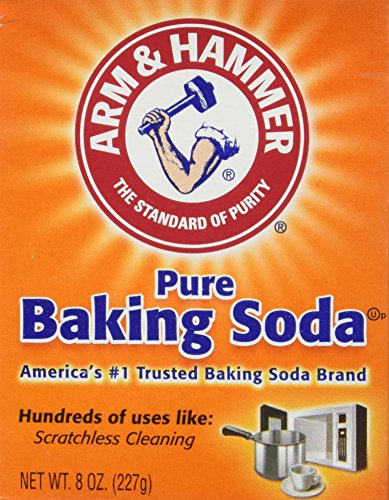 Like vinegar, baking soda is another common household product that has dozens of cleaning uses. You can use it as a simple, effective pre-treatment for dye stains as well!
Like vinegar, baking soda is another common household product that has dozens of cleaning uses. You can use it as a simple, effective pre-treatment for dye stains as well!
- In a clean bowl or measuring cup, mix ⅓ cup of warm water with about six tablespoons of baking soda. You need enough soda to create a nice thick paste, but not so much that it becomes dry and crumbly.
- Rub the paste into the dye stain, using gentle, circular motions. You can do this with your fingers or with a clean paper towel.
- Allow the paste to dry. This will take at least a couple of hours, but you may want to let it sit overnight to be safe.
- Over a sink or wastebasket, crumble the biggest clumps of baking soda off the fabric.
- Place the clothing in your washer, and run it through a cold water cycle using your normal detergent.
- Hang up the garment to air dry.
- Check to see if the stain came out!
4. Hydrogen Peroxide and Dish Soap
 Hydrogen peroxide acts as a gentler form of bleach and does a great job lifting away dye stains for this reason. This happens because hydrogen peroxide contains one more oxygen molecule than a water molecule does, giving it oxidizing powers that break down many stains! In fact, many oxygen bleaches contain a large percentage of hydrogen peroxide.
Hydrogen peroxide acts as a gentler form of bleach and does a great job lifting away dye stains for this reason. This happens because hydrogen peroxide contains one more oxygen molecule than a water molecule does, giving it oxidizing powers that break down many stains! In fact, many oxygen bleaches contain a large percentage of hydrogen peroxide.
You will want to perform a spot test to ensure that the peroxide will not damage your garment before trying this method.
- After performing a spot test to make sure the hydrogen peroxide will not leach color away from your garment, spread out the stained area on top of a clean paper towel.
- Drench a cotton ball in hydrogen peroxide and apply it to the stain.
- Hopefully, you will quickly see color staining the white cotton ball. This means you have successfully removed some of the dye!
- Keep going with a clean cotton ball.
- When you no longer see the stain on the fabric, rinse out the peroxide in cold water.
- Run the garment through a wash cycle by itself. Use cold water and regular detergent. If the stained clothing is white, you can add one cup of hydrogen peroxide in place of bleach to brighten it even more!
5. Ammonia and Dish Soap
 In some cases, you can use a strong mixture of ammonia, water, and dish soap to remove even very stubborn red dye stains. Ammonia smells pretty awful, it’s true, but it really does work! Just make sure you have a good source of ventilation nearby as you work on this method.
In some cases, you can use a strong mixture of ammonia, water, and dish soap to remove even very stubborn red dye stains. Ammonia smells pretty awful, it’s true, but it really does work! Just make sure you have a good source of ventilation nearby as you work on this method.
Also, do not ever mix ammonia with bleach. In general, mixing cleaning products is a bad idea as it could cause a dangerous chemical reaction.
- Measure out one tablespoon of ammonia, one teaspoon of dish soap, and a quart of warm water into a clean bucket.
- Dip the stained area of the garment into this solution and allow it to soak for half an hour.
- Rinse out the ammonia in cool water.
- Examine the garment to see if any dye remains. If it does, repeat this process.
- Finally, place the clothing in your washing machine and run it through a cold water cycle.
Commercial Products
You may find it convenient to use cheap or readily available household products, but sometimes commercial products designed for specific stain removing purposes will do the job more quickly and effectively!
6. Bleach
 In almost all cases you should use oxygen bleach rather than chlorine bleach to treat dye stains in clothing. The exception to this rule is white clothing–if you carefully spot test first you may want to use chlorine bleach to fully remove dye from white clothes.
In almost all cases you should use oxygen bleach rather than chlorine bleach to treat dye stains in clothing. The exception to this rule is white clothing–if you carefully spot test first you may want to use chlorine bleach to fully remove dye from white clothes.
Oxygen bleach interacts with water to release oxygen particles, which lift many types of stains out of fabric. This kind of bleach will not have the super-strong fumes you would associate with chlorine bleach, and it also does not have such a caustic effect on the fabric.
The safest way to apply oxygen bleach to your clothes is through a soak.
- Fill a clean bucket with enough cold water to cover the piece of clothing.
- Pour in ¼ cup of liquid oxygen bleach, or stir in powdered bleach in the amount indicated on the package. If you use powdered bleach, make sure it dissolves before adding the clothing.
- Allow the garment to soak for thirty minutes.
- Inspect the stain–has it disappeared? If not, return the clothing to the bleach soak for another 30 minutes.
- Rinse the bleach out in cold water.
- If you used chlorine bleach, you will need to neutralize it by also rinsing the garment in hydrogen peroxide before moving on to the wash.
- Finally, wash the garment in your washing machine using cold water and normal detergent.
7. Stain Removers
 You can find a wide variety of commercial stain removers on the market, including the popular RIT Dye Remover and OxyClean Stain Remover.
You can find a wide variety of commercial stain removers on the market, including the popular RIT Dye Remover and OxyClean Stain Remover.
To use either of these products, you’ll want to follow the directions on the package. This should also tell you what types of fabric you can use the product on.
In general, though, you apply the stain remover as a pre-wash treatment directly on the stain. In some cases, you may need to allow the stain remover to sit for a period of time. Then you wash the garment in cold water in your washing machine.
Most stain removers should not damage your clothing, but you should still perform a spot test on an inconspicuous area first to make sure you don’t see any discoloring from the product.
8. Color Run Remover
 Color run removers act a lot like stain removers or oxygen bleach but are intended for use in a load of laundry that had dye bleed all over it. For example, if you accidentally washed a brand new pair of jeans with your favorite bed sheets, you probably ended up with blue stains on the sheets!
Color run removers act a lot like stain removers or oxygen bleach but are intended for use in a load of laundry that had dye bleed all over it. For example, if you accidentally washed a brand new pair of jeans with your favorite bed sheets, you probably ended up with blue stains on the sheets!
Mixing one to three packets of a color remover in with the laundry as you run it through the wash again should remove the dye, in theory.
Popular brands of color run removers include Carbona and RIT Laundry Treatment. These products usually cost around $5 per packet.
How to Get Dye Out of White Clothes
The best way to get dye out of white clothes is to use the vinegar or hydrogen peroxide methods described earlier in this article, but you can also apply a chlorine bleach soak if the type of materials allows this treatment.
Chlorine bleach will powerfully remove stains from white clothing, but it can also damage certain kinds of material. In fact, if applied directly to fabric, chlorine bleach can eat through fibers and damage most types of material!
If you decide to use a chlorine bleach soak, follow these steps:
- Set up your space safely with an open window or running fan for ventilation. Wear goggles and gloves to protect yourself from any splashes, and cover your floor with a plastic tablecloth if you can.
- Fill up a clean bucket with cold water. Measure in ¾ cup of bleach for every gallon of water in the bucket.
- Gently place the garment in this solution, trying not to splash.
- Let the clothing soak for five minutes.
- Drain away the bleach water.
- Fill up another bucket with water and add one-tenth as much hydrogen peroxide as water. This will neutralize the bleach and prevent it from continuing to eat away at the fabric.
- Soak the garment in the neutralizing hydrogen peroxide solution for ten more minutes.
- Finally, rinse the clothing in cold water and launder it as usual.
How to Remove Dye Transfer From Clothes
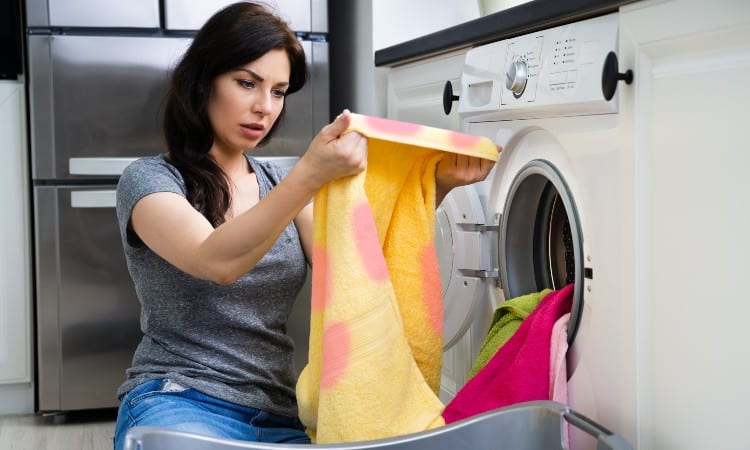
The best way to remove dye transfer from clothes is to use oxygen bleach. You can do this for a whole load of laundry at a time, and the heavily diluted bleach will remove dye more effectively than most natural methods. Natural methods such as using vinegar will work just fine, but they work better on a case-by-case basis, rather than for a whole load of laundry at once!
So, what is dye transfer? Dye transfer means that color escaped from one piece of clothing and leaked onto another, creating a colorful stain.
This happens when you wash an item that is not colorfast with other clothing. New blue jeans, for example, quite often cause this problem when you forget and put them in the laundry with other clothing!
While this happens most often in the washing machine, other items such as a freshly dyed tie-dye t-shirt could also transfer dye onto other clothing as well. Another popular culprit is hair dye–sometimes an errant strand of hair drips right onto a bath towel or t-shirt while you’re in the middle of the dyeing process!
Blue Dye
To treat a blue dye transfer, use the rubbing alcohol method. Isopropyl alcohol will almost always remove blue dye from clothing, white shoes, and carpets! Just remember to keep using new cotton balls soaked in alcohol when you see the blue transfer to the cotton ball.
In a pinch, you can also use hand sanitizer, as this product usually has a high alcohol content as well!
Blue dye is a prime offender for dye transfer because it’s really difficult to truly make it colorfast in many kinds of clothing. For example, indigo dye is the stuff that gives your Levis jeans that distinctive denim color. Repeated washing does make it less likely that your jeans will bleed blue everywhere, but new jeans will turn a whole clothing blue if you aren’t careful!
Red Dye
Red dye transfers can prove quite tricky to entirely remove from clothing, but using several different soaks including vinegar and ammonia will often do the trick.
- First, use the ammonia method in this way: fill a bucket with two tablespoons of ammonia, two teaspoons of dish soap, and two quarts of water.
- Place the red-dye-stained garment in this solution, and allow it to soak for an hour.
- Rinse out the garment thoroughly in cool running water. You should no longer smell ammonia in the clothing when you have finished with this part of the process.
- Next, set up another soak, this one using two tablespoons of distilled white vinegar and two quarts of warm water.
- Soak the clothing with the vinegar solution for an hour.
- Rinse the garment for a second time.
- Hang it up to drip-dry.
Alternatively, you can try using a commercial color run remover if you had red dye transfer over a lot of laundry at once. Red dye is difficult to remove, though, so you may have to treat every garment on its own.
Tie Dye
You can almost always get tie-dye color out of clothing using the ammonia method. For small stains, the hydrogen peroxide method will also work well. Both of these methods work best on a fresh stain, though, rather than on a stain that has gone through the dryer.
If you need to get tie-dye out of clothes after washing, you can try using the rubbing alcohol method (which will also work on a fresh stain, of course!). Use copious amounts of rubbing alcohol and make sure you have a fresh paper towel or clean rag beneath the stained area to catch escaping color.
You may have to repeat the process multiple times, as the heat of the dryer will likely have made the dye transfer set into the garment.
Hair Dye
The best way to get hair dye out of clothes is to catch the stain as soon as possible and immediately place a dab of laundry detergent on the stain. If the stain does not come out after you rinse the detergent away, try using the oxygen bleach method.
You can use an oxygen bleach soak safely on most color-fast clothing. If you still have hair dye in your clothes after this, put the garment through a cold water washing cycle to remove any traces of the oxygenated bleach.
As a last resort, you can also try the chlorine bleach method. This desperate measure could damage the clothing and works best on white clothing.
How to Remove Dye Transfer Stains From Colored Clothes
You can use vinegar, hydrogen peroxide, or even oxygen bleach to remove dye transfer stain from colored clothes. You should not use chlorinated bleach as this will very likely take the original color out of the clothes as well as the transferred dye.
That said, some experts do suggest using a chlorine bleach soak but only allowing the colored clothes to remain in the bleach solution for five minutes. the short time may remove the transferred color without damaging the garment.
Natural methods like using vinegar or hydrogen peroxide provide a gentler treatment that works really well, especially if you catch the stained garment before it has gone through the dryer!
How to Get Dye Out of Clothes After Washing
You can sometimes get dye out of clothes after washing using the rubbing alcohol method. This may prove effective, especially on a small stain.
Using the vinegar and dish soap method on a clean rag may work as well, though you will likely need to repeat the process multiple times.
In all honesty, though, it becomes much more challenging to get dye out of clothes once the heat of the dryer has set it into the fabric. At this point, you find that buying a new piece of clothing will cost less than spending a lot of time and cleaning products trying to get a stain out of an old garment!
How to Remove Color Bleeding From Clothes Naturally
The safest way to remove color bleeding from clothes naturally is to use the vinegar soak method described earlier in this article. Vinegar’s natural acidity makes it an excellent and cheap stain remover!
Of course, the absolute best, natural way to handle color bleeding is to pay attention before you put things in the wash and wash similar colors together. That way, even if a red shirt does bleed color, it will only touch other red clothes!
If you have the time, handwashing new, brightly colored clothes is a good idea as well. This allows the excess dye to bleed off in a safe way, where it cannot touch other clothes.
Best Dye Remover for Clothes
Across the board, rubbing alcohol is often considered the best dye remover for clothes. It lifts many types of stains and does especially well with ink and dye stains. As an added benefit, it does not let off noxious fumes and it doesn’t cost much!
In terms of commercial products, oxygen bleach comes in a strong second. This type of bleach is a lot safer for you and your clothing than chlorine bleach. It has a powerful ability to get colorful stains out of most types of clothing, and can even treat a whole load of dye-transferred laundry at once!
Big-names brands like OxyClean, Clorox, and Ajax all offer oxygen bleach products to make your laundry life easier.
Conclusion
You can get dye out of clothes using household products such as rubbing alcohol, hydrogen peroxide, and vinegar. You can also safely apply oxygen bleach to most clothing to successfully remove dye transfer. Other commercial products such as dye run removers and stain removers often work well too, though they do cost more than a household product.
Red dye requires special treatment and repeated soaking to truly lift away the color transfer. Other types of dyes such as blue dye will easily stain clothing but will wash away very easily as well.
What was the worst dye stain you ever encountered? How did you handle it? Leave a comment below to let us know!